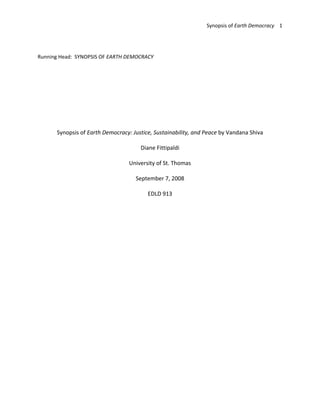
Earth democracy
- 1. Synopsis of Earth Democracy 1 Running Head: SYNOPSIS OF EARTH DEMOCRACY Synopsis of Earth Democracy: Justice, Sustainability, and Peace by Vandana Shiva Diane Fittipaldi University of St. Thomas September 7, 2008 EDLD 913
- 2. Synopsis of Earth Democracy 2 Synopsis of Earth Democracy: Justice, Sustainability, and Peace by Vandana Shiva Vandana Shiva based her book, Earth Democracy: Justice, Sustainability and Peace, (2005) on the premise that the rise of capitalism and corporate globalization produced monopolies causing an unprecedented concentration of wealth and power. Shiva asserts these monopolies amassed their power by the systematic exploitation of natural resources and the dismantling of local economies. As a result, Shiva believes we live in a world where commerce and profit take priority over people and nature. In fact, Shiva goes so far as to claim that global corporations secure their profits by “pushing peasants to suicide, the poor to hunger and thirst, the youth to unemployment.” (p.75). As an advocate for change, Shiva makes accusations such as these throughout the book in an attempt persuade readers to reject globalization in favor of an alternative based on the premise of earth democracy. Earth Democracy promotes the responsible use and conservation of natural resources through communal ownership; Shiva (2005) advocates “freely sharing the earth’s resources, not monopolizing and privatizing them.” (p.4). Three basic concepts define earth democracy, they are: living economies, living democracies and living cultures. In this paper I will explain these premises and show how earth democracy is shaped by each. Our world is dominated by the market economy where we exchange goods and services for a price determined by supply and demand. Shiva (2005) stresses the dominance and oppressiveness of the free markets where multinational agribusiness has displaced diverse crop plantings with large scale monoculture farms. In response, Shiva proposes the existence of two additional economies: nature’s economy and the sustenance economy. Together these economies comprise the living economy which focuses on people; an economy “where the currency is not money but is life”. (p.33). Nature’s economy provides us with the goods and services produced by nature such as water, fertile soil and the flora to survive. The goods and services provided by local human production and delivered in balance with nature comprise the sustenance economy. Together these two economies thrive when local
- 3. Synopsis of Earth Democracy 3 communities cooperate, when local citizens watch over natural resources and use them with restraint. As a result, the living economy emerges as one leg of a three‐legged stool known as earth democracy. Shiva (2005) calls the second concept that defines earth democracy, living democracy. This concept rejects the idea that elected governments represent the will of the people. Much like Karl Marx, Shiva believes those with means maintain control over government. Protectionism for companies like Monsanto, create a situation where peasant farmers, once producers of their own seed, are now consumers of corporate seed. In living democracies, local communities hold the power to make decisions in a more inclusive approach to self‐rule. The concept of living democracy redefines representative government and demands the return of decision‐making power to individuals and local communities allowing them to control the use of their resources and protect their livelihoods. Shiva (2005) calls the third and final concept that defines earth democracy, living culture. Based on the principle of diversity, this concept embodies a society where people of all different cultures, religions and lifestyles live together united in their concern for the earth. Living cultures regard both natural resources and life as sacred. This concern for life stems from a universal compassion for each other. In living cultures, diverse populations recognize their interdependence and as a result collaborate peacefully. Shiva (2005) presents a one‐sided case. In follow up, our class should discuss counter arguments and their merits. For example, is globalization completely evil or can we identify contributions or positive outcomes? Shiva (2005) points out the oppression and irresponsibility of Monsanto and Coca Cola but can we identify socially responsible corporations, or are there none? On the reverse side of the argument, Shiva paints the self‐rule of localized communities as infallible, but does corruption and power mongering occur within all forms of society? Are living cultures always non‐ violent, inclusive and compassionate? Shiva’s presentation leaves these questions unanswered.
- 4. Synopsis of Earth Democracy 4 References Shiva, V. (2005). Earth democracy: Justice, sustainability, and peace. Cambridge, Massachusetts: South End Press.
